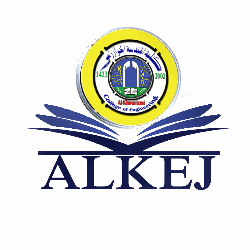Effect of MIG Welding Parameters on the Mechanical Properties of AISI 304 Austenitic Stainless Steels
DOI:
https://doi.org/10.22153/kej.2022.01.001Abstract
The present research investigates joints welding of 304L austenitic stainless steel using metal inert gas (MIG) welding method. The research explores the effect of process parameters (arc voltage, wire feed rate, and electrode wire diameter) on the mechanical properties of stainless steel. The above variables are varied respectively with 18.5, 19, 19.5 V, 116, 127, 137 mm/s, and 0.8, 1, 1.2 mm, with E308L as a filler electrode. The design matrix of the experiments was determined using the design of experiment (DOE) program Minitab 17 based on the levels of input elements used. The Taguchi orthogonal matrix methodology (Taguchi) technique was used to develop some empirical analysis for the maximum tensile strength and proper surface hardness as a function of the welding parameters mentioned above. The ( ) analysis was used to statistically verify the model's adequacy. The results show that the wire feed rate had the greatest effect on the tensile strength of the welded joints when choosing the medium level of arc voltage (19 V), while the arc voltage had a substantial influence on the micro-hardness of all welded joints. The weld-joint zone is given a higher micro-hardness value compared to the base metal zone.
Downloads
References
R.Molak and K. Paradowski, “Measurement of mechanical properties in a 316L stainless steel welded joint”, International Journal of Pressure Vessels and Piping, vol. 86,pp. 43–47, 2009.
A.S. Hameed,“Experimental investigation for multi characteristics optimization of MIG welding on 304 stainless steel using desirability function analysis”, JOURNAL OF MINES, METALS & FUELS. vol. 68, No.4, pp. 144 – 149, 2020.
Gulencand B.Develib,” Experimental study of the effect of hydrogen in argon as a shielding gas in MIG welding of austenitic stainless steel”. International Journal of Hydrogen Energy, vol. 30: pp. 1475 – 1481, 2005.
Salah S. Abed-Alkareem “Determination of Welding Velocity and Arc Energy for Fusion MAG Welding Joint” Al-Khwarizmi Eng. Journal, Vol. 10, No. 4, pp. 64 – 80 2014.
Abid Al-Sahib N.K., Adnan N. Abood and Amer A. Tuama “Welding of Low Alloy Steel DIN ISMO3 by MIG/MAG Spot “AL-Khwarizmi Eng. Journal, Vol.2, No. 2, pp. 1 – 19 2006.
Furusawa and K. Yasuda, “The Effect of Gas Metal Arc Welding (GMAW) processes on different welding parameters”. Procedia Engineering, vol. 41, pp 1502 – 1506, 2012.
L. S. Kumar S. M. Verma, and B. Suryanrayana, “Analysis of welding characteristics on stainless steel for the process of TIG and MIG with dye penetrate testinhg”. International Journal of Engineering and Innovative Technology, vol. 2, pp. 283 – 290, 2012.
V. Chauhan and R. S. Jadaun, “Parametric Optimization of MIG Welding for Stainless Steel (SS-304) and low carbon steel using Taguchi Design Method”, International Journal of Recent Scientific Research. vol. 6, pp. 2662 – 2666, 2015.
I. M. Omiogbemi and D. S. Yawas,” EFFECTS OF METAL INERT GAS WELDING PARAMETERS ON SOME MECHANICAL PROPERTIES OF AUSTENITIC STAINLESS STEEL IN ACIDIC ENVIRONMENT”, Nigerian Journal of Technology (NIJOTECH), vol. 36, No. 3, pp. 835 – 843, 2017.
S. A. Rizvi and W. Ali, “Optimization of Welding Parameters and Microstructure and Fracture Mode Characterization of GMA Welding by Using Taguchi Method on SS304H Austenitic Steel”, Mechanics and Mechanical Engineering, Technical University of Lodz, vol. 22, No.4, pp.1121-1131, 2018.
Er. Saurabh and V. S. Aher,” PARAMETRIC OPTIMIZATION OF MIG WELDING PROCESS TO IMPROVE ITS TENSILE STRENGTH”, International Journal of Research and Development, vol. 4, pp. 75 – 82, 2019.
A. Furqan and M. Amarnadha, “OPTIMIZATION OF MIG WELDING PARAMETERS FOR IMPROVING STRENGTH OF WELDED JOINT”, Journal of Interdisciplinary Cycle Research, vol. 6, pp 128 – 135, 2020.
ASTM, "Standard specification for heat-resisting chromium and chromium-nickel stainless steel plate, sheet, and Strip for Pressure Vessels", A240, 2006.
IEEE Criteria for Class IE Electric Systems, IEEE Standard 308, 1969.
American Society for Metal, “ASM Metal Handbook”, Vol.21 Copyright 2012.
E. Dean, R. Unal, “Taguchi Approach to Design Optimization for Quality and Cost: An Overview,” Int. Soc. Parametr. Anal., pp. 1–10, 1991.
O. Hinkelmann, “Design and Analysis of Experiments, Introduction to Experimental Design”. Canada: John Wiley & Sons, Inc., 2008.
Kumar A, Gautam SS, Kumar A. Heat input and joint efficiency of three welding processes TIG, MIG and FSW using AA6061. Int J Mech Eng Rob Res, vol. 1, p.p. 89–94 2014.
T. E. Abioye and O.O. Gbadeyan, "Analysis of the mechanical properties and penetration depth of gas metal arc welding on AISI 304 stainless steel," Int. J. Microstructure and Materials Properties, vol. 14, No. 1, 2019.
David, S.S. Babu, & J.M. Vitek, "Welding Solidification and Microstructure", Oak Ridge National Laboratory, Vol. 32, No. 3, 2003.
Herry and Oktadinata, "Microstructure and Hardness Profile of Dissimilar Lap Joint OF Type 304 Stainless Steel to SS400 Carbon Steel”, Kementerian Perindustrian Metal Indonesia, vol. 41 No. 2, pp. 47-54, 2019
Downloads
Published
Issue
Section
License
Copyright: Open Access authors retain the copyrights of their papers, and all open access articles are distributed under the terms of the Creative Commons Attribution License, which permits unrestricted use, distribution and reproduction in any medium, provided that the original work is properly cited. The use of general descriptive names, trade names, trademarks, and so forth in this publication, even if not specifically identified, does not imply that these names are not protected by the relevant laws and regulations. While the advice and information in this journal are believed to be true and accurate on the date of its going to press, neither the authors, the editors, nor the publisher can accept any legal responsibility for any errors or omissions that may be made. The publisher makes no warranty, express or implied, with respect to the material contained herein.








